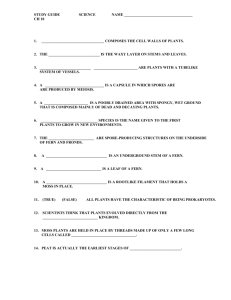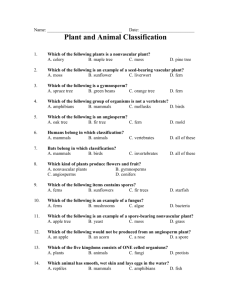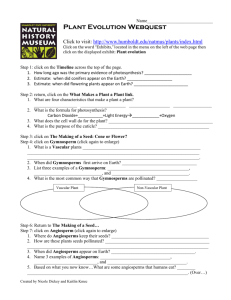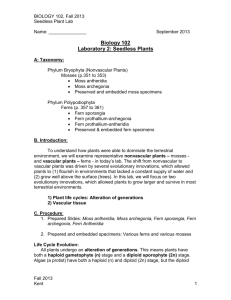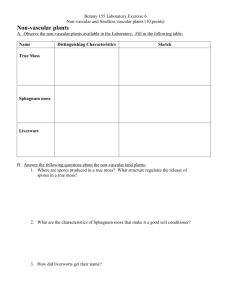Plant Kingdom Lab
advertisement
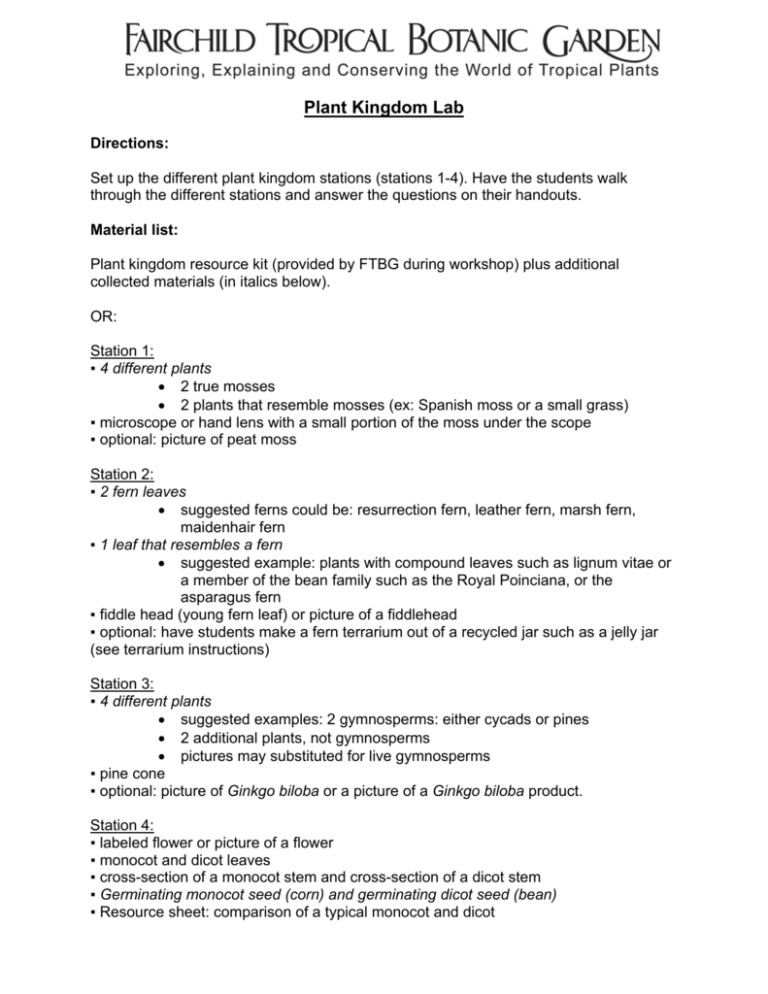
Plant Kingdom Lab Directions: Set up the different plant kingdom stations (stations 1-4). Have the students walk through the different stations and answer the questions on their handouts. Material list: Plant kingdom resource kit (provided by FTBG during workshop) plus additional collected materials (in italics below). OR: Station 1: ▪ 4 different plants • 2 true mosses • 2 plants that resemble mosses (ex: Spanish moss or a small grass) ▪ microscope or hand lens with a small portion of the moss under the scope ▪ optional: picture of peat moss Station 2: ▪ 2 fern leaves • suggested ferns could be: resurrection fern, leather fern, marsh fern, maidenhair fern ▪ 1 leaf that resembles a fern • suggested example: plants with compound leaves such as lignum vitae or a member of the bean family such as the Royal Poinciana, or the asparagus fern ▪ fiddle head (young fern leaf) or picture of a fiddlehead ▪ optional: have students make a fern terrarium out of a recycled jar such as a jelly jar (see terrarium instructions) Station 3: ▪ 4 different plants • suggested examples: 2 gymnosperms: either cycads or pines • 2 additional plants, not gymnosperms • pictures may substituted for live gymnosperms ▪ pine cone ▪ optional: picture of Ginkgo biloba or a picture of a Ginkgo biloba product. Station 4: ▪ labeled flower or picture of a flower ▪ monocot and dicot leaves ▪ cross-section of a monocot stem and cross-section of a dicot stem ▪ Germinating monocot seed (corn) and germinating dicot seed (bean) ▪ Resource sheet: comparison of a typical monocot and dicot Plant Kingdom Lab Mosses (Station 1) You might have heard of plants called, “Spanish moss” or “ball moss.” This common name is misleading because the plant is not a moss at all, but a flowering plant. Observe these plants and determine which are true mosses and which are not. Remember: • True mosses are small, but carry out photosynthesis using the green pigment, chlorophyll, like other land plants. • Mosses have no vascular tissue, wood, true leaves, or flowers. • Flowering plants can have very small flowers that are hard to spot. Decide whether each plant is a moss or not. Place an “x” next to the answer on your worksheet. 1. 2. 3. 4. ______moss ______moss ______moss ______moss ______not a moss ______not a moss ______not a moss ______not a moss Look at the moss under the microscope. Notice that the plant does not have vascular tissue. Mosses reproduce by spores produced by the sporophyte. How is the sporophyte different than the gametophyte? USES for MOSSES: In Ireland and other northern European countries, people use peat for fuel. The accumulation and compression of mosses and other plants that grow in bogs form peat. Ferns (Station 2) Plants need water throughout their bodies, much like we need blood that’s carried through out blood vessels. Plants without vessels remain small because they have no system for transporting water. Ferns are among the first group of plants that developed vascular tissue to transport water. 5. Look for a main vessel or vein in this fern frond. How many main veins do you see on one frond? Like mosses, ferns reproduce with spores. The spores are often found on the underside of a frond, collected in packets called sori. Look at the underside of the fern with a hand lens. Not all ferns look like the typical “feathery” fern, but all reproduce with spores, not seeds from flowers. Which of these plants are ferns? 6. 7. 8. ______fern ______fern ______fern ______not a fern ______not a fern ______not a fern USES for FERNS: Some people eat the incompletely opened leaves of ferns in the spring. These are called fiddleheads. But don’t try this yourself! Not all ferns are edible and some are poisonous. Gymnosperms (Station 3) Gymnosperms are woody trees and shrubs that produce cones. Gymnosperm means “naked seed”. Unlike the angiosperms, gymnosperm seeds are not enclosed by the fruit. Instead, the seed are exposed on the scales of female cones. Some plants look like gymnosperms but are angiosperms and other plants look like angiosperms but are gymnosperms! Here you’ll see several plants. Look for cones and identify the gymnosperms. Place an “x” next to the answer on your worksheet. 9. ______gymnosperm 10. ______gymnosperm 11. ______gymnosperm 12. ______gymnosperm ______not a gymnosperm ______not a gymnosperm ______not a gymnosperm ______not a gymnosperm USES for GYMNOSPERMS: Some people use conifers as holiday decorations in their homes. Other people use Ginkgo biloba as an herbal treatment for memory loss. Can you remember any other uses for gymnosperms? Angiosperms (Station 4) This group of plants protects its seeds in a fruit that develops from the ovary of the flower. Angiosperms are divided into two major groups: monocots and dicots or more formally • • Class Monocotyledonae - plants with one seed leaf Class Dicotyledonae - plants with two seed leaves Use the sheet titled “Comparison of Typical Monocots and Dicots” to decide which of the following are monocots (M) or dicots (D). 13. flower 14. leaf 15. germinating seed a) ________ a) ________ b) ________ b) ________ a) ________ b) ________ USES for ANGIOSPERMS: As the most abundant group in the plant kingdom, angiosperms have uses too numerous to mention. Try thinking of a few uses, other than food. Name __________________ Plant Lab Answer Sheet Mosses (Station 1). 1. 2. 3. 4. Please put an “x” next to your choice. ______moss ______moss ______moss ______moss ______not a moss ______not a moss ______not a moss ______not a moss Ferns (Station 2). Please put an “x” next to your choice for numbers 6 to 8. 5. How many major veins do you see on one fern frond? _____ 6. ______ fern ______not a fern 7. ______ fern ______not a fern 8. ______ fern ______not a fern Gymnosperms (Station 3). 9. ______ gymnosperm 10. ______ gymnosperm 11. ______ gymnosperm 12. ______ gymnosperm Angiosperms (Station 4). 13. flower 14. leave 15. germinating seed Please put an “x” next to your choice. ______not a gymnosperm ______not a gymnosperm ______not a gymnosperm ______not a gymnosperm Please write “m” for monocot or “d” for dicot. a) ________ a) ________ b) ________ b) ________ a) ________ b) ________


